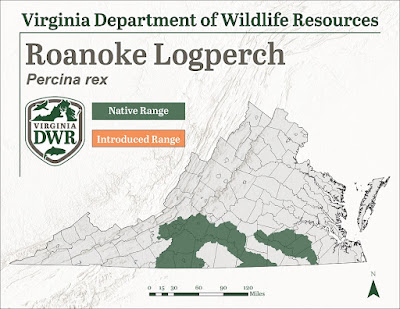Article by Ed Coleman, Virginia Master Naturalist, Southwestern Piedmont
On April 1, 2024, the U.S. Fish and Wildlife Service announced a proposal to remove the Roanoke Logperch (Percina rex) from the Federal List of Endangered and Threatened Wildlife. In the proposal, the U.S. Fish and Wildlife Service stated that "threats to the Roanoke logperch have been eliminated or reduced to the point that the species no longer meets the definition of an endangered or a threatened species under the Endangered Species Act of 1973." The federal agency has determined that this large freshwater darter is no longer at risk of extinction as populations are shown to be stable or expanding and reproducing. When the Roanoke logperch was added to the federal list in 1989, they were found in only 14 streams in Virginia, compared with a 2019 survey which found the species in 31 streams in Virginia and North Carolina.
Success for the comeback is attributed to aquatic-restoration projects, removal of artificial barriers such as dams that isolated populations, and the creation of fish passageways. The end result has connected hundreds of miles of habitat allowing fish from one population to move to another, thereby expanding genetic diversity as well. Even so, the geographic range of the Roanoke Logperch is still very limited, endemic only to the southern Piedmont of Virginia and northern North Carolina. The species is found in larger streams in the upper Roanoke, Smith, Pigg, Otter, and Nottoway River systems and Goose Creek in Virginia and in the Dan, Mayo, and Smith River systems and Big Beaver Island Creek in North Carolina.
 |
| Map showing the geographic range of the Roanoke Logperch in Virginia |
Photo Credit: Virginia Department of Wildlife Resources https://dwr.virginia.gov/wildlife/information/roanoke-logperch/
While Percina rex may be considered the "king" of freshwater darters, because of its size relative to the other ten members in the Percina genus, this small fish only grows up to six inches in length. Other identifying characteristics described by the Virginia Department of Wildlife Resources include having a moderately long, pig-like snout, round or vertically elongate lateral blotches on its body, strongly patterned fins, and a marginate or truncated tail fin. During the breeding season, the dorsal fins and spots on mature males turn bright orange.

Photo of the Roanoke Logperch (Percina rex)
Photo Credit: Roanoke logperch, Hagerty, Ryan/USFWS, Public Domain, https://www.fws.gov/media/roanoke-logperch-4
Like most darters, the Roanoke Logperch lives on the bottom of streams and rivers, preferring clear, swift water with rocky or sandy substrate. Large pectoral fins help them stay low in the water as they skim across the bottom feeding on benthic macroinvertebrates such as mayflies, caddisflies, and stoneflies or their larvae. They actively hunt using their elongated snouts to flip over small pebbles at the bottom of rivers and streams to expose prey. Roanoke Logperch also spawn in clear, swift currents, however, fertilized eggs usually float downstream to be deposited among the slower-moving shallow pools near the water’s edge.
Delisting a species from the Federal List of Endangered and Threatened Wildlife is always a cause for celebration. For the Roanoke Logperch, it has taken 35 years to reach this status at a cost that would be near impossible to estimate. But the lessons learned along the way have been invaluable. Simply put, dams without fish passageways isolate fish populations and trash, chemicals, and excessive sediment in the waterways destroy fish and their habitats. There are four other federally listed endangered fish in Virginia and 24 species of fish listed as either threatened or endangered by the Virginia Department of Wildlife Resources. As Master Naturalists, we can make a difference for the remaining endangered and threatened fish in Virginia by volunteering for riparian buffer cleanups and teaching our friends and neighbors about the environmental benefits of maintaining vegetated buffers along streams sides.
A word of caution, while the U.S. Fish and Wildlife Service has proposed to delist the Roanoke Logperch from the Federal list of Endangered and Threatened Wildlife, the fish is listed as threatened or endangered by the Virginia Department of Wildlife Resources as well as the North Carolina Wildlife Resources Commission. It is illegal to target Roanoke Logperch by angling. It is a violation of state and federal law to harass, harm, or take any Roanoke Logperch.
Sources:
https://www.fws.gov/species/roanoke-logperch-percina-rex
https://dwr.virginia.gov/wildlife/information/roanoke-logperch/




No comments:
Post a Comment